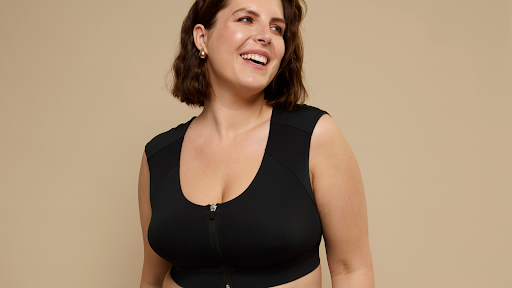Everyday routines often take a toll on the back. From prolonged sessions at a desk to carrying groceries, these repetitive tasks can gradually lead to chronic aches. As a result, many seek solutions that offer both relief and prevention. For certain individuals, a posture bra presents an appealing option, aiming to keep the spine supported while easing stress on the shoulders. Physical therapists, who frequently treat discomfort related to alignment, have shared insights about the potential benefits and limitations of such undergarments.
Subtle support with noticeable impact
Within the first few weeks of wearing a specialized bra, some people notice less tightness in their upper backs and reduced neck stiffness. However, there’s a distinction between a traditional bra and a posture corrector model. The latter typically incorporates wider, stronger straps and reinforced back panels that gently align the shoulders. Physical therapists see merit in these features, as proper positioning can help curb the uneven muscle strain that often leads to pain.
A supportive garment by itself doesn’t magically eradicate long-term misalignment, yet it can function as a gentle reminder. By exerting mild tension on the shoulders, it prevents the wearer from unconsciously reverting to a hunched pose. Over days and months, this could diminish reliance on compensating muscles that strain to hold the body upright. Many therapists encourage patients to combine this approach with exercises that reinforce the core, ultimately offering an even greater reduction in pain.
Understanding the therapeutic rationale
Therapists note that posture-related backaches stem from subtle imbalances. When the shoulders roll forward, certain muscle groups overwork while others weaken. This disparity increases the likelihood of knots and discomfort. A posture bra is designed to apply steady support across the back, limiting the amount of forward slumping that might occur during typical daily activities.
Several factors influence how effective the bra can be. Fabric breathability matters for all-day wear, especially for those who sweat easily or live in warm conditions. Adjustability also comes into play. A bra that’s too tight may create new pressure points instead of preventing discomfort. Meanwhile, a garment that’s too loose won’t offer the intended benefits. Physical therapists often advise patients to pay close attention to fit and comfort, making minor strap or band adjustments as needed.
Beyond just wearing the garment
Even the sturdiest design needs complementary support. Most therapists recommend pairing the bra with movement breaks throughout the day, such as gentle stretches for the shoulders, neck, and upper back. These simple intervals help release any tension that builds up over working hours. A strong core is also essential. Planks, bridge poses, and controlled weightlifting exercises each target the muscles that stabilize the spine.
By combining a posture bra with these targeted activities, individuals typically see better results. Over time, standing or sitting straighter becomes second nature. Therapists often caution against treating the garment as a cure-all. Instead, it should act as part of a holistic plan—one that addresses body mechanics, daily habits, and muscle conditioning.
Notable models earning professional praise
In discussions on posture solutions, some products stand out for their design. An Etalon example, therapists say, uses both high-grade materials and a carefully engineered fit. Such a bra balances firm reinforcement with enough flexibility to remain comfortable during varied tasks. Lightweight but durable boning panels may add more structure, while moisture-wicking fabric keeps the skin dry.
Therapists occasionally reference these standout models when guiding patients who want a dependable garment. Key indicators of quality include broad, cushioned straps, an adjustable back closure, and reinforced stitching. However, they stress that individual comfort trumps any label. A brand might be well regarded, but if it doesn’t adapt to the wearer’s unique proportions or lifestyle, its benefits diminish.
Realistic expectations and limitations
While many appreciate the relief a supportive undergarment can offer, physical therapists highlight the importance of realistic goals. Poor alignment arises from years of habit in most cases, so a single item of clothing won’t immediately reverse that. The garment is best viewed as an accessible tool rather than a miraculous solution.
Chronic back issues may also be rooted in conditions like scoliosis or disc problems. In such cases, wearing a supportive bra could ease some stress but won’t correct structural abnormalities. That’s why therapists encourage people to seek professional evaluation if serious or persistent pain exists. They emphasize that a posture bra works best as part of a broader plan, which might encompass targeted stretching, chiropractic adjustments, and other therapies.
Day-to-day comfort and awareness
People who incorporate a posture-oriented design into their routines often report feeling more conscious of their stance. Whether typing, walking, or sitting on the couch, the gentle reminders from the garment can prompt them to reposition and avoid slouching. Over time, that awareness may become automatic, even without the bra.
Aside from enhanced alignment, wearers sometimes notice improved confidence. Standing upright with open shoulders can convey assurance in social and professional settings. Physical therapists recognize that posture isn’t purely physical—mental and emotional well-being can also improve when the body feels strong and balanced.
The opinions of physical therapists on posture bras highlight a nuanced balance between support and self-care. With sturdy back panels and wider straps, these garments can help counter the slumping habits that contribute to back pain. Yet, they’re most effective when paired with simple posture checks, exercises that strengthen core muscles, and breaks that release tension.
For anyone struggling with ongoing discomfort, a posture bra may offer meaningful relief by distributing weight more evenly and reducing stress on vulnerable muscle groups. Meanwhile, professional guidance can ensure the bra fits well and aligns with individual needs. The combined insights of skilled therapists and a willingness to embrace healthier habits often lead to more enduring comfort—proof that a thoughtful approach can make all the difference in tackling everyday back woes.







